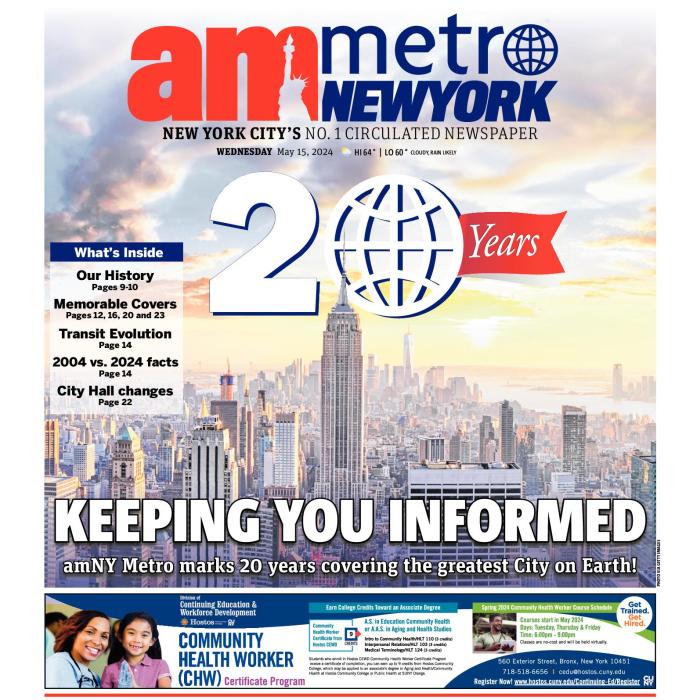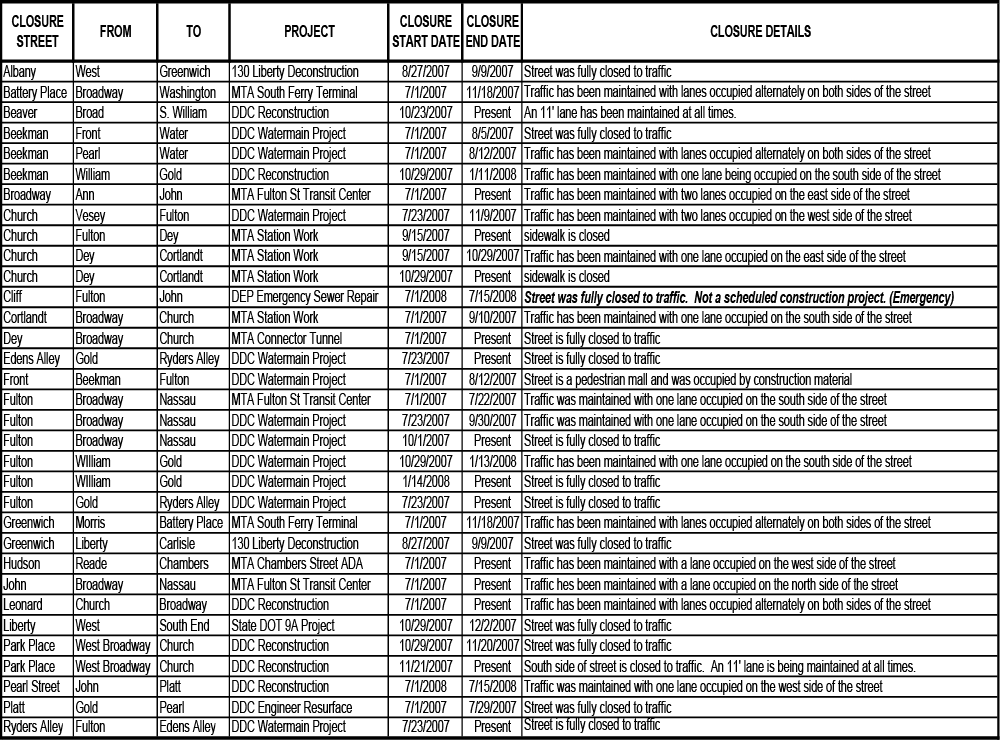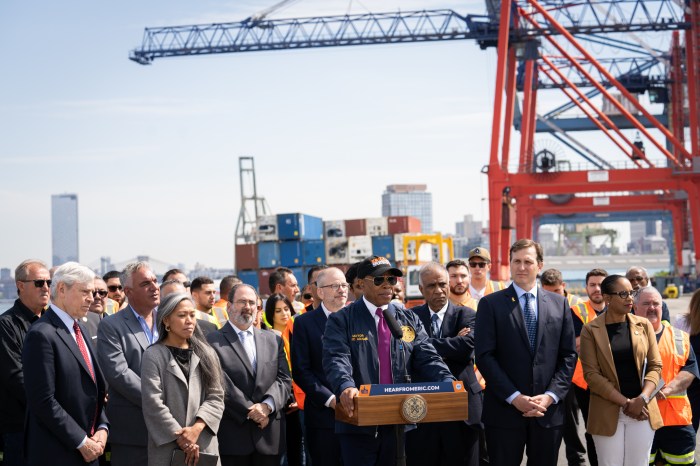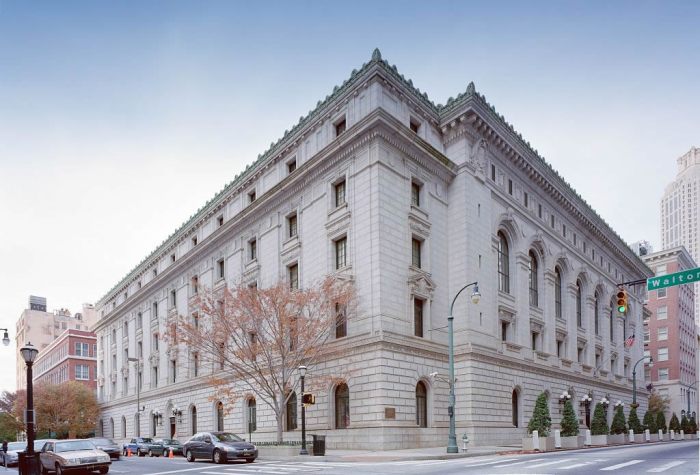By Julie Shapiro
For more than 40 years, Fulton Supply, a hardware store, has stood on Fulton St., drawing business from tourists and local workers.
List of all eligible blocks from July 2007 through January 2008
But as construction took over the street last summer, Alex Portnoy, the owner for the last 4 ½ years, saw fewer and fewer people enter the store.
“It’s crazy, very crazy, very bad,” Portnoy said from behind his counter, as he fetched custom-made keys. Over the summer, the city dug an enormous trench in what used to be a bustling street, corralling foot traffic along narrow sidewalks behind plywood barriers. “They cannot see us,” Portnoy said.
Portnoy’s story of confusion, frustration and resignation is common among small-business owners struggling to stay solvent while dozens of construction projects rip apart streets across Lower Manhattan.
To help these business owners, the Lower Manhattan Development Corporation and the city launched a
$5 million Small Firm Assistance Program, which will pay street or basement level retail businesses $2.50 per square foot per month affected by construction, up to $25,000. If the square foot subsidy figure ends up exceeding the amount of money the business lost, the shop will be compensated only for the loss.
The program is retroactive to July 1, 2007, and the L.M.D.C. will take applications until April 30, 2011 or until the funding runs out. The money could help at least 200 businesses in Lower Manhattan.
The L.M.D.C. was supposed to announce the program last Friday with Assembly Speaker Sheldon Silver and the city’s Small Business Services, but the winter’s first snowstorm got in the way. Although the L.M.D.C. has begun accepting grant applications, the corporation declined to comment until the L.M.D.C. makes an official announcement. Officials hope to get the first checks in the mail in about 60 days.
For Portnoy’s 1,100-square-foot shop between Ryders Alley and Gold St., the program means $2,750 a month. According to an L.M.D.C. chart, his block has already been affected by the installation of a new water main for seven months, bringing his potential total to $19,250 so far.
“It’s definitely going to help,” Portnoy said as he crunched the numbers on a calculator in his store.
The assistance won’t come a moment too soon. In addition to losing foot traffic, Portnoy is also having trouble getting deliveries. The trucks that deliver cans of paint, for example, are too big to pull up near his store, and even if they do squeeze in, they get a ticket. So, Portnoy instructs the truck drivers to get as close as they can, and then he sends his employees with hand trucks to pick up the paint.
To be eligible for a grant, a retail business must be below Canal St., have 50 or fewer employees and demonstrate a financial downturn. Also, the business must have a street-level entrance on a block that was closed or partially closed for at least 15 days during any 30-day period because of a publicly funded construction project. The application form and the full eligibility requirements are on the L.M.D.C.’s Web site, renewnyc.com.
The L.M.D.C. has released a list of all eligible blocks from July 2007 through January 2008 and will update that list monthly on its Web site. Some of the most affected blocks during that period were Broadway between Ann and John Sts.; Dey St. between Broadway and Church Sts.; Fulton St. between William and Ryders Alley and Broadway to Nassau; and John St. between Broadway and Nassau St.
To prove a financial impact, a business must submit statements showing that sales or revenue were lower while construction work blocked the street.
Ayhan Sav, who owns The Country Kebab at Fulton and Gold Sts., was glad to hear of the L.M.D.C.’s new grant program.
“I will definitely apply,” she said over the phone. “It wasn’t so easy for us — I’m behind on some of my rent, trying to catch up.”
The water shutoffs, which are part of replacing the 150-year-old water main beneath Fulton St., paralyzed Sav’s business for hours at a time. When the city first broke ground on the project, hordes of rats flooded the street, and it was nearly impossible to keep them out of the ground-floor restaurant, she said.
Business has been slow since last summer, and Sav sees no end in sight. She and her husband opened The Country Kebab about six years ago and also own five other restaurants Downtown, all of which have been affected to some degree by construction, she said. Together, the businesses have fewer than 50 employees, so Sav expects to be eligible for funding, though she didn’t know how many square feet she had.
Isaak Zaurov, owner of Isaak’s Fulton Haircutters, was skeptical about the L.M.D.C.’s grants.
“The program is not going to help businesses that much,” Zaurov said in a phone interview. “If they would finish it faster, that would be a lot better than any money they give.”
As the construction rumbles on, Zaurov has seen few new customers, though his regulars still know where to find the 14-year-old shop. On a recent afternoon, only one chair had a customer, while the rest sat empty. Zaurov wishes the city would build a bridge across Fulton St. and widen the sidewalks.
Zaurov said the city told him the construction would only last for several weeks, then they said 10 weeks, then 18 months. And while the pace of work was fast at the beginning, with as many as 50 workers per block, Zaurov said the site has gotten sleepy.
“It looks the same since Christmas,” Zaurov said, and several other business owners agreed.
Zaurov also quibbled with the L.M.D.C.’s formula for compensation, which is based on area. At 250 square feet, Zaurov’s shop would receive $625 a month. Meanwhile, his rent is $4,000. “We lose a lot more than $600 a month,” he said.
J.C. Chmiel, co-owner of the coffee bar Klatch, at 9 Maiden Ln., was frustrated to hear that his block is not eligible for funding. Maiden Ln. has been closed many times for construction, especially after a Con Edison transformer explosion in February 2007. But since the streets were clear before last July, the L.M.D.C.’s starting date for the grants, Chmiel won’t get reimbursed for lost business.
“It’s well known that Maiden Ln. was a terrible construction zone for the longest time,” Chmiel said in a phone interview. Last spring, the Lower Manhattan Construction Command Center held a meeting with Maiden Ln. businesses specifically to address the effects of traffic interruptions. The foot traffic and revenues noticeably plummeted, especially when the sidewalk immediately in front of Klatch was ripped up several times.
“The small businesses of Lower Manhattan have been suffering greatly since 9/11,” Chmiel said. “Now they’re trying to put some finite, arbitrary, small window — it seems not fair to those who went through the construction before that timeframe.”
Late on a recent afternoon, Mr. Rafael’s Cleaners, on Fulton St. between William and Gold Sts., was full of clothes but empty of customers.
Alex Costa, who works behind the counter, said the noise and barriers keep customers away. “People are lazy — they just go somewhere else,” Costa said. “People walking on the other side don’t see the signs.”
Costa hadn’t heard about the L.M.D.C. program and wouldn’t be the one to decide whether to apply, he said. Meanwhile, there’s not much he can do, so “we’re waiting,” he said, sighing.
Julie@DowntownExpress.com

















